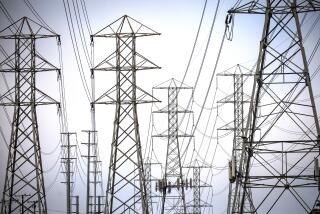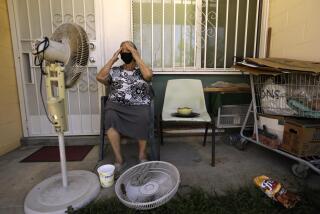EARTHWATCH : Keep Your Cool : There are several easy steps you can take to make your air conditioner run more efficiently.
- Share via
Unless you live on the coastline, it’s hot this time of the year. So you flip on the ol’ central air-conditioning, listen for the satisfying ca-chink of the solenoid cranking up the unit and wait for the cool air of modern technology to bathe the sweat from your brow.
Sounds fine, until you get the electric bill. What’s this? It says you used as much juice as the entire city of Santa Paula did last month. It’s that air conditioner, you exclaim to anyone who will listen. You didn’t purposely waste electricity. You’re the type of person who turns off lights in rooms that nobody is using, puts in long-lasting light bulbs, and turns the television off whenever you leave the room for more than a few minutes. It’s that blasted air conditioner that’s doing it.
Well, yes and no. Sure, the air conditioner is putting an extra strain on the budget, but many of us who are real conservation nuts about light bulbs and stove pilot lights don’t even think about the central air conditioner. But you can stay cool and cut down the outflow of hard-earned cash by servicing your air conditioner to maximize its efficiency.
Most manufacturers say the first thing to do is to have your equipment checked out. And if you haven’t done so in a year or two, whatever the service charge is, it really wouldn’t hurt to have someone come over and take a look. Now, here is where common sense comes in.
If the unit is working properly and is less than 5 years old, service consultants from a number of manufacturers say, “If it ain’t broken, don’t fix it.” OK, but there are a number of things you can do to make sure your air conditioner works easier.
The most common maintenance point is to regularly change the air filter on the indoor part of the air conditioner.
The air filter keeps the machine from sucking up muck as it draws in air to cool down and blow out through the vents. As the filter gets dirty, the air conditioner has to work harder to get the air it needs to do the job. The more it works, the more juice it needs and, you get the idea, the higher your electric bill, not to mention the wear and tear on the equipment.
But when the maintenance person comes, don’t point in the direction of the air conditioner and go back to watching television. Watch what he or she is doing. More important, find out exactly where that air filter is so that next time, instead of calling out the cavalry, you can do it yourself.
If you’re going to do it yourself, make sure the unit is off. Now, if you remembered where the maintenance person found it, or you have the instruction book that came with the unit, look for the air filter. There’s a good chance it’s made of blue gauzy stuff in a black cardboard frame, with a thin aluminum grid of round circles on one side to hold it together.
As you slide the filter halfway out, look carefully at how it fits. Found that piece of thin aluminum with the round circles? Remember on which side it goes. It’ll be important later.
Now, take it outside (stay inside if you like, but don’t be angry when a lot of the sooty glop on the filter falls onto your floor) and carefully look for some numbers on the outside of the black cardboard frame. Sooner or later, you’ll find something like 12 x 15, or 20 x 25. That translates to 12 inches by 15 inches and 20 inches by 25 inches. It can be any set of dimensions, so don’t worry if these aren’t your numbers.
Write down the numbers (once you see the dozens of sizes, you’ll be glad you wrote them down) and head off to the garden, discount or do-it-yourself store of your choice. Buy two or three or four. They’re cheap, so why run to the store every few months for another? Store the others in a closet, but be careful, they’re easily damaged.
Remembering which side had the aluminum grid, slide the new air filter back into its snug home. (Some filters have an arrow printed on the side to indicate the direction of air flow.) Button up the machine and fire it up. Put a piece of tape on the inside of the door with the date on which you changed the filter. Three months from now, change it again.
But that’s not the only thing you can do to lengthen the life of your air conditioner and reduce electricity consumption. You can see if there are any coolant leaks.
In the morning, put a thermometer by one of vents and let it get good and cold from the air blast for about five or 10 minutes. Record the temperature and do it for five days straight, preferably at the same time of the day so that the outside temperature will be as uniform as possible).
If the temperature stays the same, it doesn’t necessarily mean you have enough refrigerant, but it will probably indicate that there are no leaks. If the temperature gradually rises over the period, you may have a leaky valve or cracked hose somewhere that is leaking coolant. Since some types of coolants are the enemy of the Earth’s ozone layer, by fixing leaks you are not only saving money but also protecting the atmosphere.
Is your house or apartment empty all day because you’re at work, but you leave the air conditioner on anyway in order to come home to a nice, cool place? You’re wasting electricity. Not to mention that you are wearing out the air conditioner.
Many units can be connected to a thermostat with a built-in timer (perhaps a little expensive, but it’s a one-time-only cost) that can be set to turn on the air conditioner about an hour before you come home and turn it off about an hour after you go to bed. Caution. Unless you’re a skilled electrician, replacing a thermostat is something you shouldn’t do yourself--this is your house wiring you’re playing with, so let a professional do it.
If you don’t have a maintenance book, get one. Somewhere on the machine is a plate that states the manufacturer and model. Call or write a letter and ask for a replacement. There may be a small charge.
Inside will probably be a list of servicing points that a homeowner can regularly do by himself or herself. Familiarize yourself with the machine’s main on/off switch in case of an emergency, and go outside and clean the leaves and junk off the external parts of the air conditioner. And when you turn off the air for the last time this year, think about wrapping up that external casing in a plastic garbage bag to keep the rain and dirt out. You’d do the same for a back-yard barbecue, wouldn’t you?
But if all this is still too technical for you, don’t be afraid to call a maintenance person. Find out if a friend uses someone, and if he or she is satisfied, call and see if that person will service your equipment. Or look in the Yellow Pages under “Air-Conditioning Contractors & Systems.”
When the heat is gone and it’s time to wonder if the furnace is going to work, make a note to yourself to call for servicing, or at least change the filter, just before the hot weather sets in next year. Wouldn’t it be nice to know of any cooling problems before the heat sets in again?


